Difference Between Block Cipher and Stream Cipher

Block ciphers and stream ciphers are two primary types of symmetric-key encryption algorithms used in cryptography. They differ in several key aspects:
-
Block Size and Operation:
- Block Cipher: Operates on fixed-size blocks of plaintext, typically 64 or 128 bits in length. The plaintext is divided into blocks, and each block is encrypted independently using the same key. Examples include DES, AES, and Blowfish.
- Stream Cipher: Operates on individual bits or bytes of plaintext, encrypting or decrypting one bit or byte at a time. The encryption process typically involves combining the plaintext with a pseudorandom keystream generated from a secret key. Examples include RC4, ChaCha20, and Salsa20.
-
Mode of Operation:
- Block Cipher: Can be used in various modes of operation to encrypt data of arbitrary length, including Electronic Codebook (ECB), Cipher Block Chaining (CBC), Counter (CTR), and Galois/Counter Mode (GCM).
- Stream Cipher: Does not require modes of operation as it inherently operates on a continuous stream of data. However, certain stream cipher designs may include feedback mechanisms to enhance security or provide error detection and correction.
-
Parallelism:
- Block Cipher: Typically operates in parallel on multiple blocks of data, allowing for efficient encryption and decryption of large datasets.
- Stream Cipher: Operates sequentially, encrypting or decrypting one bit or byte at a time, which may result in slower processing compared to block ciphers for certain applications.
-
Performance and Efficiency:
- Block Cipher: Often provides better performance for bulk encryption of large volumes of data due to its ability to process multiple blocks in parallel.
- Stream Cipher: May offer better efficiency for real-time communication or streaming applications, where data is processed continuously in small increments.
-
Security Characteristics:
- Block Cipher: Vulnerable to certain types of attacks, such as ciphertext-only attacks and chosen-plaintext attacks, especially if the same key is reused for multiple blocks or if the encryption mode is not properly implemented.
- Stream Cipher: Vulnerable to attacks such as known-plaintext attacks and chosen-plaintext attacks, particularly if the keystream is predictable or if synchronization between the sender and receiver is compromised.
In summary, while both block ciphers and stream ciphers are used for symmetric-key encryption, they differ in their operating principles, block or bit-level processing, modes of operation, and performance characteristics. The choice between block ciphers and stream ciphers depends on factors such as the specific requirements of the cryptographic application, security considerations, and performance constraints.
Thank you,
